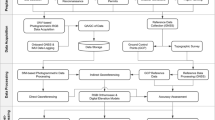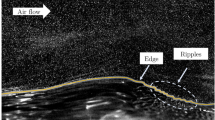Abstract
Knowledge of the effects of small-scale fluctuations in temperature on light transmission in the atmosphere is necessary for the calibration of remote sensing instruments as well as for the understanding of turbulent heat transport in the atmospheric boundary layer. Recent developments in small unmanned aircraft systems (sUAS) have allowed for direct, spatial in situ estimation of temperature in the ABL at very high temporal and spatial resolutions. Structure functions are estimated from vertical profiles of temperature collected using an ultrasonic anemometer mounted on an sUAS. Using geostatistical methodologies specifically developed for spatially non-stationary and spatially dependent random variables, we estimate temperature structure from six profiles reaching roughly 500 m in altitude A mean function is specified to account for the variation in temperature with altitude and the structure function is estimated from the residuals. A 2/3 scaling exponent is fitted to the resulting curves commensurate with the inertial subrange of turbulence. The resulting structure functions of residuals are able to resolve the inertial subrange on most profiles at a range of separation distances. We find that geostatistical methods for spatially non-stationary random variables are well suited in certain cases to describing the vertical structure of temperature in the boundary layer.








Similar content being viewed by others
References
Antonia RA, Hopfinger EJ, Gagne Y, Anselmet F (1984) Temperature structure functions in turbulent shear flows. Phys Rev A 30(5):2704
Avery AS, Whyte S, Brenner J, Natalie VA, Jacob JD (2019) Experimental measurement of flow field around a rotary wing unmanned aircraft for evaluation of onboard anemometer placement. In: 72nd Annual meeting of the APS division of fluid dynamics
Barbieri L, Kral ST, Bailey SCC, Frazier AE, Jacob JD, Reuder J, Brus D, Chilson PB, Crick C, Detweiler C, Doddi A, Elston J, Foroutan H, González-Rocha J, Greene BR, Guzman MI, Houston AL, Islam A, Kemppinen O, Lawrence D, Pillar-Little EA, Ross SD, Sama MP, Schmale DG, Schuyler TJ, Shankar A, Smith SW, Waugh S, Dixon C, Borenstein S, de Boer G (2019) Intercomparison of small unmanned aircraft system (sUAS) measurements for atmospheric science during the LAPSE-RATE Campaign. Sensors 19(9):2179
Bonin TA, Goines DC, Scott AK, Wainwright CE, Gibbs JA, Chilson PB (2015) Measurements of the temperature structure-function parameters with a small unmanned aerial system compared with a sodar. Boundary-Layer Meteorol 155(3):417–434
Braam M, Beyrich F, Bange J, Platis A, Martin S, Maronga B, Moene AF (2016) On the discrepancy in simultaneous observations of the structure parameter of temperature using scintillometers and unmanned aircraft. Boundary-Layer Meteorol 158(2):257–283
Brock FV, Richardson SJ (2001) Meteorological measurement systems. Oxford, New York
Calmer R, Roberts GC, Preissler J, Sanchez KJ, Derrien S, O’Dowd C (2018) Vertical wind velocity measurements using a five-hole probe with remotely piloted aircraft to study aerosol–cloud interactions. Atmos Meas Tech 11(5):2583–2599
Chiles J-P, Delfiner P (2012) Geostatistics: modeling spatial uncertainty. Wiley, New York
Cioni S, Ciliberto S, Sommeria J (1995) Temperature structure functions in turbulent convection at low Prandtl number. EPL 32(5):413–418
Cressie N (1990) The origins of kriging. Math Geol 22(3):239–252
Cressie N (1993) Statistics for spatial data. Wiley, New York
Donnell GW, Feight JA, Lannan N, Jacob JD (2018) Wind characterization using onboard IMU of sUAS, AIAA Aviation
Gawedzki K, Kupiainen A (1995) Anomalous scaling of the passive scalar. Phys Rev Lett 75:3834–3837
Grossmann S, Lohse D (1994) Scale resolved intermittency in turbulence. Phys Fluids 6(2):611–617
Harrison RG (2015) Meteorological measurements and instrumentation. Wiley, New York
Higgins CW, Wing MG, Kelley J, Sayde C, Burnett J, Holmes HA (2018) A high resolution measurement of the morning ABL transition using distributed temperature sensing and an unmanned aircraft system. Environ Fluid Mech 18(3):683–693
Jacob J, Chilson P, Houston A, Smith S (2018) Considerations for atmospheric measurements with small unmanned aircraft systems. Atmosphere 9(7):252
Koch SE, Fengler M, Chilson PB, Elmore KL, Argrow B, Andra DL Jr, Lindley T (2018) On the use of unmanned aircraft for sampling mesoscale phenomena in the preconvective boundary layer. J Atmos Ocean Technol 35(11):2265–2288
Kolmogorov AN (1941a) Local structure of turbulence in an incompressible fluid for very large Reynolds numbers. Dokl Akad Nauk SSSR 30:299–303
Kolmogorov AN (1941b) Interpolation and extrapolation of stationary sequences. Izvestiya the Academy of Sciences of the USSR. Ser Math 5:3–14
Konrad T, Hill M, Rowland R, Meyer J (1970) A small, radio-controlled aircraft as a platform for meteorological sensors. Johns Hopkins APL Tech Dig 10:11–19
Lee TR, Buban M, Dumas E, Baker CB (2017) A new technique to estimate sensible heat fluxes around micrometeorological towers using small unmanned aircraft systems. J Atmos Ocean Technol 34(9):2103–2112
Mandelbrot BB, Van Ness JW (1968) Fractional Brownian motions, fractional noises and applications. SIAM Rev 10(4):422–437
Marusic I, Heuer WD (2007) Reynolds number invariance of the structure inclination angle in wall turbulence. Phys Rev Lett 99(11):114504
Matheron G (1963) Principles of geostatistics. Econ Geol 58:1246–1266
Mathieu J, Scott J (2000) An introduction to turbulent flow. Cambridge University Press, Cambridge
Monin AS, Yaglom AM (1975) Statistical fluid mechanics. MIT Press, Cambridge
Myers D (1989) To be or not to be… stationary? That is the question. Math Geol 21(3):347–362
Obukhov AM (1949) Structure of the temperature field in turbulent flow. Geogr i Goofiz 2(1):58–69
Pebesma EJ (2004) Multivariable geostatistics in S: the gstat package. Comput Geosci 30(7):683–691
Platis A, Altstädter B, Wehner B, Wildmann N, Lampert A, Hermann M, Birmili W, Bange J (2016) An observational case study on the influence of atmospheric boundary-layer dynamics on new particle formation. Boundary-Layer Meteorol 158(1):67–92
Platis A, Moene AF, Villagrasa DM, Beyrich F, Tupman D, Bange J (2017) Observations of the temperature and humidity structure parameter over heterogeneous terrain by airborne measurements during the LITFASS-2003 Campaign. Boundary-Layer Meteorol 165(3):447–473
Schotanus P, Nieuwstadt FTM, De Bruin HAR (1983) Temperature measurement with a sonic anemometer and its application to heat and moisture fluxes. Boundary-Layer Meteorol 26(1):81–93
Smith M (2011) Warnings: the true story of how science tamed the weather. Greenleaf Press, Austin
Sreenivasan KR, Antonia RA (1997) The phenomenology of small-scale turbulence. Annu Rev Fluid Mech 29(1):435–472
Stull RB (1988) An introduction to boundary layer meteorology. Kluwer Academic Publishers, Dordrecht
Taylor GI (1938) The spectrum of turbulence. Proc R Soc London Ser A 164:476–490
van den Kroonenberg AC, Martin S, Beyrich F, Bange J (2012) Spatially-averaged temperature structure parameter over a heterogeneous surface measured by an unmanned aerial vehicle. Boundary-Layer Meteorol 142(1):55–77
Vindel JM, Yagüe C, Redondo JM (2008) Structure function analysis and intermittency in the atmospheric boundary layer. Nonlin Process Geophysis 15(6):915–929
Wainwright CE, Bonin TA, Chilson PB, Gibbs JA, Fedorovich E, Palmer RD (2015) Methods for evaluating the temperature structure-function parameter using unmanned aerial systems and large-eddy simulation. Boundary-Layer Meteorol 155(2):189–208
Webster R, Oliver MA (2007) Geostatistics for environmental scientists. Wiley, New York
Acknowledgements
This research is supported by a grant from the U.S. National Science Foundation (NSF) [IIA-1539070] “RII Track-2 FEC: Unmanned Aircraft Systems for Atmospheric Physics”. The authors would like to thank the students and staff of the Unmanned Systems Research Institute (USRI) at Oklahoma State University for their help in data collection, particularly Racine Swick and Victoria Natalie. The authors would also like to thank Gijs de Boer for coordinating the LAPSE-RATE field campaign during summer 2018 and our colleagues at The University of Oklahoma’s Center for Autonomous Sensing and Sampling for the surface and radiosonde data. The authors are also thankful for the helpful comments from the two anonymous reviewers.
Author information
Authors and Affiliations
Corresponding author
Additional information
Publisher's Note
Springer Nature remains neutral with regard to jurisdictional claims in published maps and institutional affiliations.
Rights and permissions
About this article
Cite this article
Hemingway, B.L., Frazier, A.E., Elbing, B.R. et al. High-Resolution Estimation and Spatial Interpolation of Temperature Structure in the Atmospheric Boundary Layer Using a Small Unmanned Aircraft System. Boundary-Layer Meteorol 175, 397–416 (2020). https://doi.org/10.1007/s10546-020-00512-1
Received:
Accepted:
Published:
Issue Date:
DOI: https://doi.org/10.1007/s10546-020-00512-1




